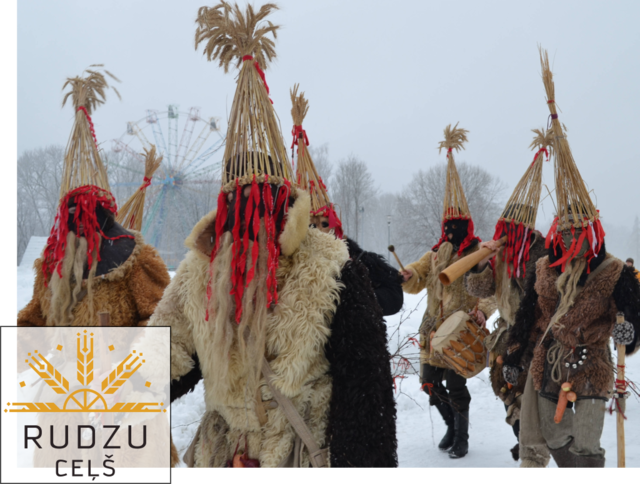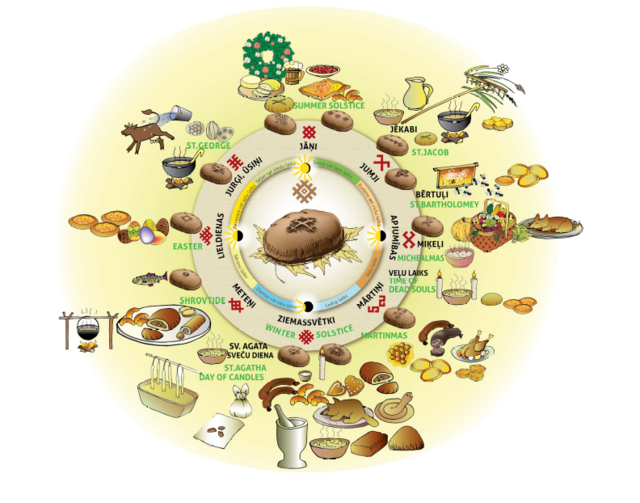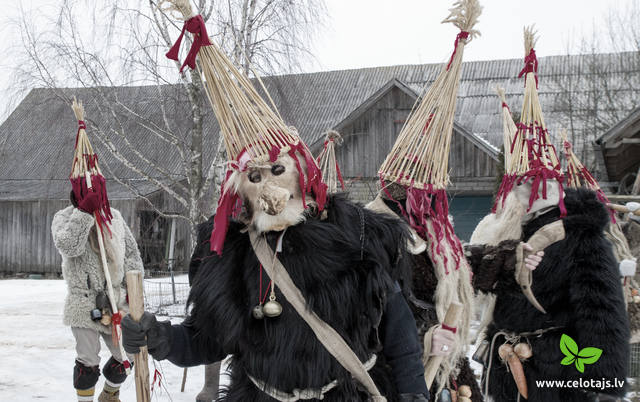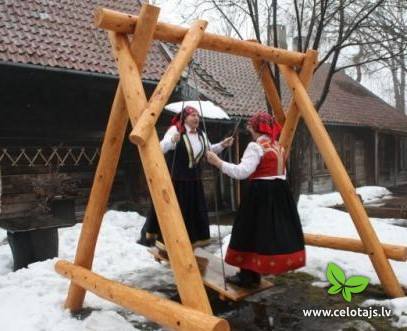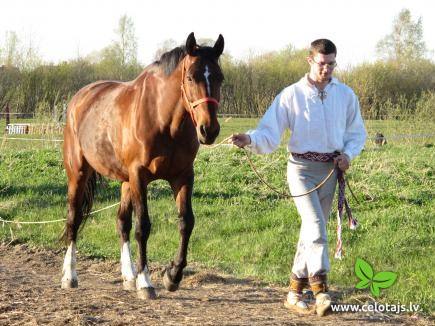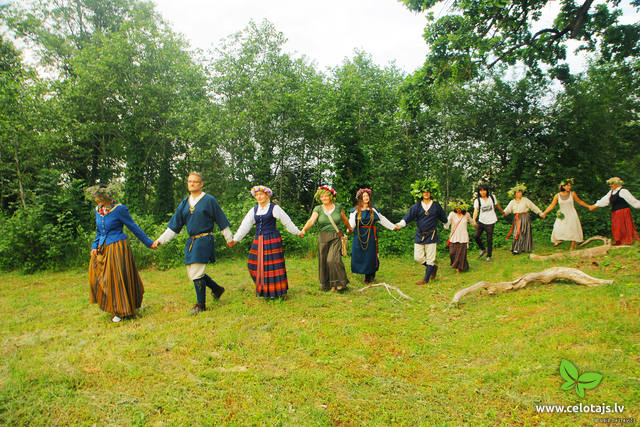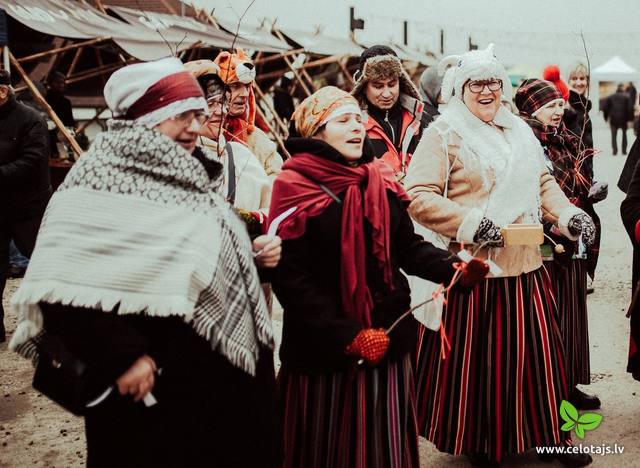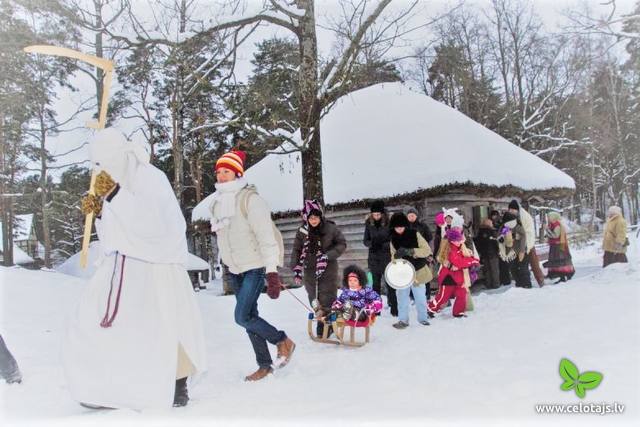Celebrations*
Bread in Latvian Annual Holiday Customs
During the year, specially baked bread was put on the table for almost all annual holidays and special days. The hostess baked rye bread and bread with other grains into loaves of special shapes or with a filling. Pies, tarts, flat cakes, buns, sheet pan pies, flatbreads were also baked. One type of pie with potato and carrot filling – "sklandurausis"" – is most popular in the Kurzeme region and together with rye bread "salinātā rudzu maize" has become a trademark of Latvian culinary heritage. The predecessor of bread, porridge from grains crushed in the masher, and dumplings were also made for holidays.
Special powers were attributed to bread baked or specially prepared for each annual holiday. This holiday bread was used in rituals to ensure health for the household and livestock and to promote a rich harvest.
The Solar Year Circle and Latvian Annual Holiday Breads, Grain and Flour Foods
The solar year circle had many holidays and special days related to annual customs and the cycle of life and work that Latvians celebrated. Each of these days had its own special traditions and rituals where bread had an important role. Bread has always had an honorary place on the table because bread is a staple of life; a source of blessing and strength.
Bread was also used in family celebrations – it was placed on the wedding table; the new wife treated the wedding guests to rye bread brought from her home; a piece of rye bread together with salt and silver coins was tied to the baby for baptising; willingly shared rye bread could remove the spell from a werewolf; it could also attract the desired man, treat illness, and protect one from evil. Bread was also given to people on their way to the Afterworld.
Read about the annual celebrations below:
Bread Calendar in the Solar Year Circle
Candle Day
Candle Day – 2 February. This day marks the middle of winter. In Catholic areas, bread baked on Candle Day was donated to the church together with other gifts.
Agatha's Day
Agatha’s Day – 5 February. This day is celebrated in the Catholic tradition in honour of St Agatha. In the Latgale region, special power is attributed to the bread of St Agatha, and the tradition is still alive in the modern day.
Meteņi
Meteņi – 6 February. Meteņi marks the beginning of spring. The ancient farmer’s working year began on Meteņi. People tried to ensure the farmers’ success with special rituals where bread and grain foods were used. They also tried to provide for prosperity, to ensure plenty of bread, their own health and the health of livestock.
Easter
Easter – Spring Equinox. Meteņi was followed by the Great day (Lielā diena), the spring equinox, the traditions of which have blended with Christian Easter. Bread baked on Good Friday and during Lent had special powers. In Lutheran areas, bread baked on Easter week was used instead of Agatha’s bread and was believed to have special powers (it was honoured in the Latgale region too). All magic with bread and grains had to be performed mainly before sunrise, as then it was especially successful.
Jurģi, Ūsiņi
Jurģi or Ūsiņi – 23 April. The midpoint between the spring equinox (Easter) and summer solstice – Jāņi. After Ūsiņš Day, grazing of horses at night and shepherding began.
On the first day of night grazing and shepherding, shepherds and farmers received special treatment. Shepherds often received a small loaf of rye bread, which was referred to by many names – abrkasītis, sakasnītis, izkasītis (scraped off dough), hare loaf, ash pie, little duck, as well as shepherd’s loaf. Egg, meat, or quark was baked into it. Bread baked on Jurģi and Mārtiņi was especially good for the health of horses, because on these days horses were fed and brushed especially well, and bread had an important role in ensuring that the farmer had happy horses.
On Jurģi, or Ūsiņš Day, the farmer had to cross the field on foot to furrow while naked in order to protect the field from weeds and ensure that the household would have bread; whereas the bread promised to Jurģis in a folk song ensured that the horses would be healthy.
On Jurģi Day, farmhands and landless peasants used to change farmers, which is why many beliefs teach how to ensure luck at the new place. Not wishing the blessings of bread and wishing quarrels onto others was the greatest evil that could be done onto someone, and this evil was done by touching the bread oven and bread baking tools on Jurģi.
Jurģi Day bread had to be sacrificed to spirits, and Catholics sanctified it in church like St Agatha’s bread and Easter bread.
Jāņi
Jāņi – Summer Solstice. Magic activities acquired special power during summer and winter solstice when blessings and a good harvest could be both attracted or cursed. Bread is also mentioned in Jāņi folk songs – as part of the feast and mainly in the context of decorating tools and fields to ensure blessings for the fields, because on Jāņi, God walks around fields and blesses them. Like for Jumis, a special large loaf was also baked for Jānis, which could not even be moved by 9 men and for which flour was milled for three mornings.
Jēkabi
Jacob’s Day – 25 July. Jacob’s Day marks the end of one stage of work and the beginning of another – haymaking was finished by Jacob’s Day, and the harvest of rye and barley was started. Jacob’s Day was the celebration of the host, and Anna’s Day (26 July) was the celebration of the hostess.
Rituals with bread were also performed at the start of harvesting, threshing and milling crops, making dough for the first batch of bread. Bread made from young rye was especially celebrated on the table on Jacob’s day. On Jacob’s Day, the hostess made rye flour porridge, baked rye bread and flat barley cakes using the flour from the new harvest. It was a special day in every ploughman’s home, and new bread was enjoyed in silence. The host received the first slice, which was believed to give strength.
Jumis
Jumis – the day when harvest ends. At the beginning of harvest, people had a symbolic meal where a loaf of rye bread had the most importance. Special attention was given to Jumis, the god of harvest, and its symbol in the cornfield – two– horned spikes of corn grown together, which were called ‘jumis’ (twin). The finder kept it and used it in rituals during harvest feasts, weddings, and to ensure the blessing of bread.
Miķeļi
Miķeļi – Autumn Equinox. All harvest was removed on Miķeļi, and only cabbage could remain in the field; everything else had to be in barns and sheds, which is why on Miķeļi the table was set with flatbreads, stew with pork or lamb and vegetables. Treating and remembering the dead – the spirits of the deceased ancestors – started on Miķeļi. In some places there was a tradition to take 3 ears from each grain, and 3 from each other plant, and sacrifice them by the cemetery in a special place. A meal in honour of the dead was more often set in a threshing barn, and rye bread was always on the table.
After harvest, threshing began. Just like for harvest feasts, there were also many different rules and beliefs for threshing and feasts to ensure plenty of crops.
Mārtiņi
Mārtiņi – 10 November. This day marks the end of autumn and the beginning of winter. When autumn work was finished, winter began, which was welcomed on Mārtiņi. This was the end of the time of the dead. Mask marches began on Mārtiņi; flat cakes, blood pancakes, blood pudding, honey flatbreads were put on the table, and sacrifices were left in the shed or stable. According to the legends, on the evening of Mārtiņi they took a loaf of bread and took it to a horse stable. There they slaughtered a rooster, and with its blood, tarnished the left hind leg of each horse. After that a loaf of bread with the rooster were carried around the horses; then the horses would not be smitten with evil spirits and their random incubus.
Christmas
Christmas – Winter Solstice. The richest traditions are related to the celebration of the returning of the sun and light – Christmas – when tables are set abundantly and the ritual meal is provided for all members of the farmstead, both people and livestock; buildings and tools also receive sacrifices. During winter solstice, bread, salt, and fire had a special honorary place on the table. Latvian folk songs known as ‘dainas’ mention a special Christmas loaf with four corners, which symbolise the four corners of the earth. The spirits of the dead are also treated to meals. The spirits are also treated with bread, meat, porridge, and beer in a threshing barn, bathhouse or in special places for sacrifice.
*Information prepared according to ethnographer I. Čekstere's materials.
Atbalsta Zemkopības ministrija un Lauku atbalsta dienests
Projekta nosaukums: Kulinārā tūrisma produkts "Rudzu ceļš". Projekta numurs: 19-00-A01630-000002.
Partneri: LLTA "Lauku ceļotājs", SIA "JS Caunītes" Vineta Cipe IK "Dzīles", z/s "Bērziņi", z/s "Buliņi", z/s "Klajumi".
Vairāk informācijas par projektu “Rudzu ceļš”
Vairāk informācijas par Eiropas Lauksaimniecības fondu lauku attīstībai pieejams EK tīmekļa vietnē
